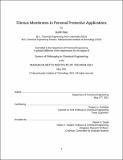Fibrous Membranes in Personal Protective Applications
Author(s)
Hao, Junli
DownloadThesis PDF (5.320Mb)
Advisor
Rutledge, Gregory C.
Terms of use
Metadata
Show full item recordAbstract
Personal protective equipment (PPE) is a collection of devices and garments that protect the wearer from hazards and threats. An important type of PPE is respiratory protection devices that reduce the exposure of the respiratory system to aerosols, which may contain harmful components that can cause infection of diseases and other health problems. Mechanical protective clothing is a type of PPE that protects against bruises, cuts, and injuries from sharp objects or even ballistic impacts. Fibrous materials of different forms have found their uses in both respiratory protection and protective clothing. For example, when used as filters in respirators and face masks, fibrous membranes can act as excellent barriers to aerosols without resulting in unreasonably high air resistance. The application of strong and tough fibrous textiles in protective clothing has continued to grow since the 1970s, replacing traditional metal and ceramic plates in many use cases because of the flexibility and the improved wear comfort of the textiles.
This thesis focuses on the applications of fibrous materials, particularly electrospun ultrafine fiber (UFF) membranes, in aerosol filters and protective clothing. The electrospun UFF membranes are first studied for their ability to alter the chemical composition of aerosols to explore the possibility of reducing human exposure to harmful aerosol constituents by selective filtration. Filtration using the UFF membranes is shown to change both the size distribution and the chemical composition of a binary liquid aerosol when the selective particle size range of the membrane is aligned with the aerosol size distribution. The size selectivity and the chemical selectivity are correlated by the composition-size relationship of the aerosol and can be tuned by adjusting membrane morphology and configuration. Then, an extensive investigation on the filtration 4 performance and mechanism is conducted for melt-blown filters in medical respirators and for alternative face mask filters, including electrospun UFF membranes. This study demonstrates that the level of electrostatic charges plays an important role in the effectiveness of the melt-blown filters. Variation in the level of the electrostatic effect results in inconsistent filtration efficiency across the examined respirators. Electrospun membranes, on the other hand, appear to be a promising alternative to the melt-blown materials due to their stability and possible reusability. Finally, electrospun UFF membranes are combined with shear-thickening fluids (STF) to improve the shape stability and the fluid retention of fabric-STF composites, which are potential materials for protective clothing and conventionally consist of microfibers. The UFF-STF composites are shape-stable and exhibit better STF retention capability due to the small pore size and the high capillary forces provided by the electrospun membrane. The addition of STF is shown to improve the mechanical responses of the membranes under impact, as the fluid can potentially hinder fiber movements and increase inter-fiber friction.
Date issued
2021-06Department
Massachusetts Institute of Technology. Department of Chemical EngineeringPublisher
Massachusetts Institute of Technology